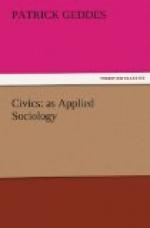So before me lies an old “bawbee” of my own home city. On one side stands the hammerman at his anvil, below him the motto of his guild, “Non marte sed arte.” Here then the industrial “Town” and its “School” express themselves plainly enough, and precisely as they have been above defined. But on the other side spreads the imperial double eagle; since Perth (Bertha aurea) had been the northmost of all Rome’s provincial capitals, her re-named “Victoria” accordingly, as the mediaeval herald must proudly have remembered, so strengthened his associations with the Holy Roman Empire with something of that vague and shadowy historic dignity which the Scot was wont to value so much, and vaunt so high. On the eagle’s breast is a shield, tressured like the royal standard, since Perth was the national capital until the “King’s Tragedy” of 1457; but instead of the ruddy lion the shield bears the lamb with the banner of St. John, the city’s saint. This side, too, has its motto, and one befitting an old capital of King and Commons, both in continual strife with the feudal nobles, “Pro Rege, Lege, et Grege.” Here then, plain upon this apparent arbitrarily levised trifle, this petty provincial money-token, this poor bawbee, that is, this coin not only of the very humblest order, but proverbially sordid at that, we find clearly set down, long generations ago, the whole [Page:99] four-fold analysis and synthesis of civic life we have been above labouring for. For what makes the industrial Town, what can better keep it than strenuous industry at its anvil? How better express its craft school, its local style and skill, its reaction too upon the town’s life in peace and war, than by this Hal o’ the Wynd by his forge? Nay, what better symbol than this hammer, this primitive tool and ever typical one, of the peaceful education of experience, form Prometheus to Kelvin, of the warlike, from Thor to modern cannon-forge? Turning now from Town and School to Cloister, to the life of secluded peace and meditation—from which, however, the practical issues of life are ever renewed—what plainer symbol, yet what more historic or more mystic one can we ask than this of the lamb with the banner? While of the contrasted yet complemental civic life of fullest, broadest action, what expression like the Roman eagle—the very eyes of keenness, and the spreading wings of power?
So rarely perfect then is this civic symbol, that I must not omit to mention that it has only come to my notice since the body of this paper, with its four-fold analysis of cities as above outlined, was essentially finished. Since it thus has not in any particular suggested the treatment of cities here advocated, it is the more interesting and encouraging as a confirmation of it. It is also to my mind plain that in this, as in many other of our apparent “advances in science,” and doubtless those in social studies particularly, we are but learning to think things anew, long after our forefathers have lived them, even




